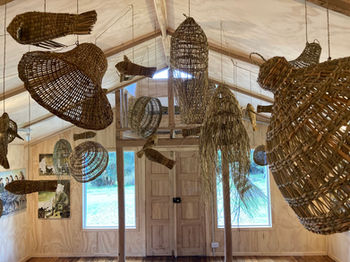WEAVING THE ISLAND
Silvia Rivera & Ismenia Duamante
September - December 2023
Creating things with our hands can be a way to transform the present moment, making it materially legible through manual activity. Chiloé natives Silvia Rivera (painting) and Ismenia Duamante (basket making) are part of an expanding and increasingly visible cultural ecosystem of artisans and artists. Rivera, a self-taught painter, seeks to develop pictorial compositions that recapture the magic of her childhood memories and imagination, where fact and fantasy merge together effortlessly. Duamante follows a multi-generational ancestral practice of gathering, preparing and taming vines and fibers from nearby forests, gradually converting them into both utilitarian and representational forms.


Silvia Rivera
Silvia Rivera Barrientos, who lives and works in Castro, was aware from an early age of being a painter, always knowing that her destiny had to do with art, even though she could not dedicate herself to it given the limitations of her family life and, later, work. Parallel to that life, Silvia filled small notebooks - a habit she has never stopped - with sketches and notes of the paintings that she would one day make when she was older. Participating in a school painting competition, she won an early prize that allowed her to travel to Spain to visit art museums, further confirming that art would be her vocation. Coming face to face with the masterpieces of Velázquez, Goya, Rembrandt and Rubens, she intuitively understood what they were about: how expression was supported by an architecture that was mysteriously revealed in the rhythm of the brush strokes, the legibility of the colors and the gestures.
Years later, Rivera bought her first professional brushes, after which she was able to paint freely. Since then it has never been entirely clear if the images she paints come from her memory, or if they are a Chilote dream of the past and future of the community. Coexisting among neighbors, family and friends, her scenes animate the daily life of a Castro that is full of traditions, legends and customs.
Rivera's paintings have a social and healing function, through scenes that come from various remembered and imagined sources. They depict what life was like before, how the Chilote stove brought people together, and how people at home lived in impoverished solidarity, or how they communed in the streets, on boats and the now-vanished train. Her imaginative freedom oscillates seamlessly between mythology, history and reality, and her paintings serve as windows to memory, showing us in 2023 the long-gone Castro train station or the ever-present palafitos coexisting with the Caleuche ghost ship, with the Pincoya, protector of the waters, or Trauko, caretaker of the forests, with the rooster that announces miracles and misfortunes, and the winged horse that lifts the spirits of a community struggling to pass its culture on to future generations.

Ismenia Duamante
The Williche basket maker Ismenia Duamante lives and works in the Agoni Alto sector in the community of Queilen. Ismenia, together with her mother, collects several types of reeds, including jonquillo, manila, totora and boqui, species that are increasingly scarce near her house. With these natural fibers, she begins the warp and weft that progressively takes various forms, from the utilitarian and functional to the purely decorative, for domestic and family use, as models for teaching through workshops, and for commercial use. The different forms that she produces all meet the objective of solving domestic and functional problems, which includes beautifying the everyday environment.
Ismenia began working as a result of a family tradition. She learned her craft through early observation, watching how her mother and grandmother transformed fibers that a few hours before were part of the beauty of the landscape. The materials were always there, between local ravines and hills, in nearby wetlands and forests. The house is equipped with bundles of fibers of different colors and shapes, each of which has undergone a different preparatory treatment.
Although Ismenia’s workshop is only a few meters from the house, the spaces around the kitchen are essential to organizing the different stages of the basket weaving process, so that what is worked on in the workshop has made its journey by way of the stove where it was cooked, and later the different parts of the house where it was dried.
Once the sticks are dry and the consistency of the fiber allows it to soften between your fingers, the final stage of the process begins. In the moment of knitting is when Ismenia feels her fingers moving naturally, as if her hands are part of a silent dance that transforms visual chaos and intuited mathematics into a rigorously geometric pattern. Whether empty or full, triangular or square, conical or cylindrical, the emerging shape that gives form to a basket, a lamp or a fruit bowl is quickly recognized. Once in use, a living geometry projects through the lights and shadows that play against floors and walls, enriching the look of the everyday world through the warmth of the fiber, and the infinite subtleties that inhabit the ocher, green and yellow tones.











